This commission piece was a delight to paint, and each day a pleasure, not work at all. As the painting progressed, I found it hard to stop at the end of each painting session. Often, I took photos of the transformations and sent them along to the clients. Because of the marvels of the iPhone camera, it was easy to document day to day progress and both send to them and keep in my files. They could easily make their own observations. I very much appreciated their input throughout, and they always had thoughtful comments and ideas of what was “in their mind’s eye”.
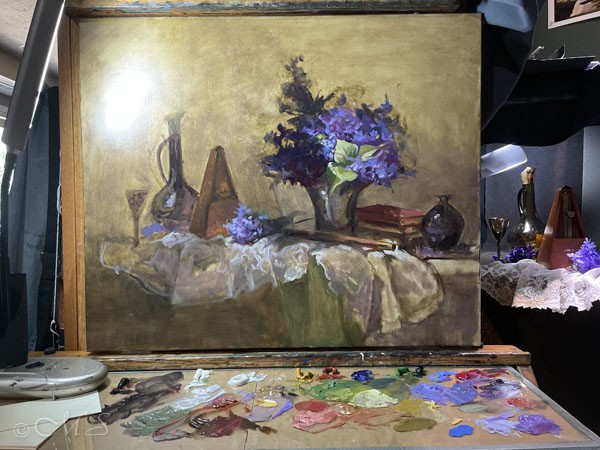
My palette is glass and is attached to my easel with clamps. Glass is easy to clean at day’s end with a window scraper and some alcohol. Whatever paint is salvageable at the end of each session I place along the upper edge with wax paper atop so it won’t dry out. Here you can see the various color mixtures. Sometimes I like to work all around the composition continuously, a little here a little there. You can see here most colors are mixed and ready to go.

A Few Changes
After a while, I felt the lilacs between the fife and the metronome were uninteresting. The clients had mentioned previously, they liked the way Jean Simeon Chardin in the example to the right here, placed books, old sheet music, and rolled papers/manuscripts in his compositions. I thought this might be an excellent solution, so I inserted the above grouping into that position. At this point, it was suggested to change the shape of the lace doily. You can see an upside-down V just above where the green under-cloth is showing. After this V was filled in with more lace, the shape had more cohesiveness to it. This change was easily done.
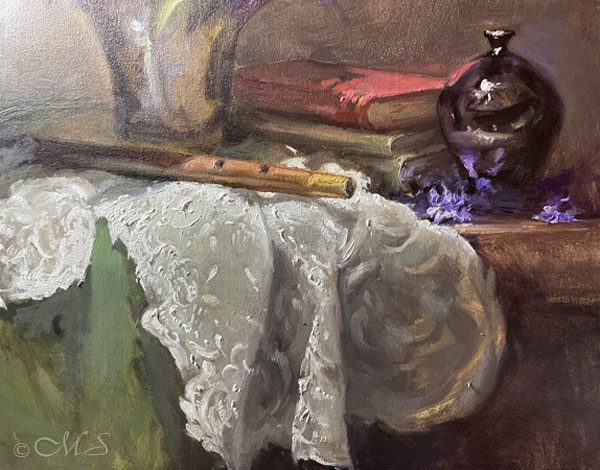
Chiaroscuro Emerges
Finally, after many weeks the painting is really taking shape with all the components working as a cohesive entity. The color theme is under control with the ease of using a limited palette. By using a minimum number of colors and using different versions of each one all throughout creates a perfect color harmony. The muted red/sienna tones are prevalent in the right-side grouping of books, in the reflection on the black vase, metronome, carafe and cordial glass, and fife. Tiny flecks of this same hue are seen in the lace, paper rolls, leaves, and vase holding the lilacs.
Chiaroscuro is nothing more than a contrast between light and dark, chiaro meaning light and scuro dark. This is the magic that makes the drama and mystery happen. This is why the objects to the left are in low light and the main objects, especially the lace, are in bright light. It’s just like we read a page in a book. Across from left to right, all the while the light builds and then voila! the main characters emerge.
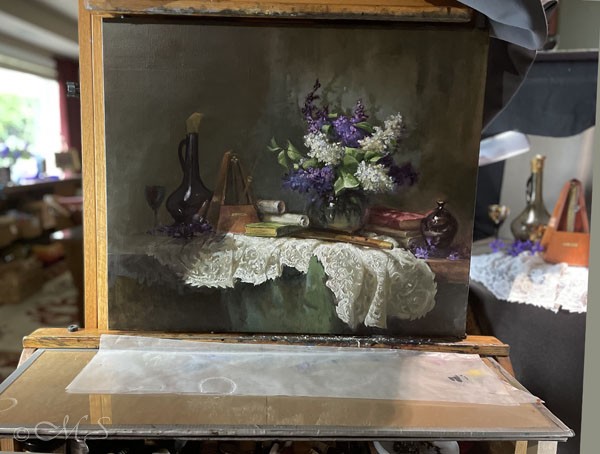
A Perfect Repoussoir
Some of you may remember my blog from many months ago featuring this technique. Repoussoir, pronounced ray-poo-swar, is a way to create an illusion of objects coming right out of the canvas. By placing something over a table edge such as a lemon or orange peel, leaves, or as I have done here with the lace, a fabric of some sort, gives the viewer the feeling of reaching out to touch the object. It also is used in landscape and figurative artwork and is loads of fun to do.
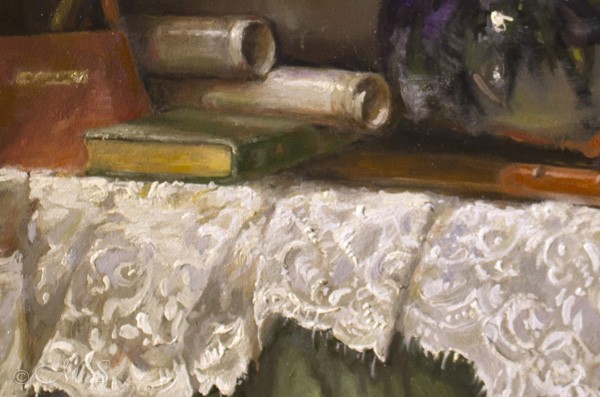
Changes Successfully Made
In the above image you can see the upside-down V is now gone and filled in with more lace and the book and rolled paper grouping inserted to add more interest in this area. So as not to copy Chardin’s painting, I altered the book/paper objects slightly by changing the colors and position. The painting is really coming together now, and I am “in the flow“. All during this time, I have been in touch with my clients and in spite of a set-back when my entire family, including me, came down with Covid, I kept pushing forward.
After many months, one last client consultation finalized loose ends. The background remained muted so as not to compete with the star performing main objects but was changed to have a smoother transition from light to dark. Bits of 24 carat gold flecks were applied to the gold trim on the carafe and cordial at the request of the clients.
The Unveiling
And now my story comes to an end. I hope you have enjoyed working with my clients along with me. They were a joy to work with on this project. It is a thrill to know they cherish their new painting and will pass it to the next generation of art lovers like themselves. The painting has no title yet. All suggestions are welcomed in the comments.
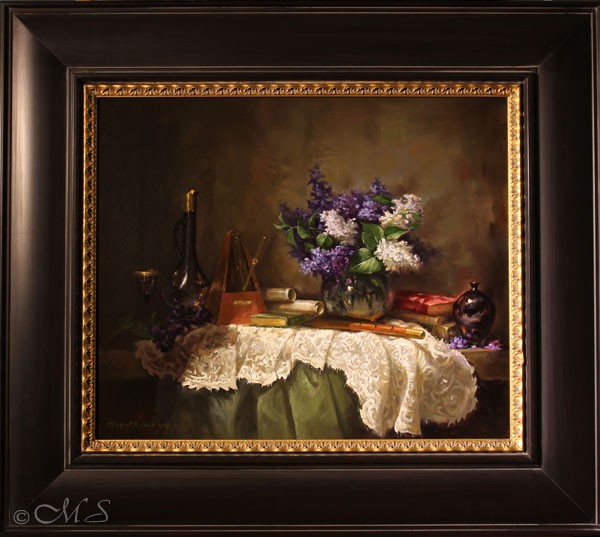

Beautiful as always. I especially like your detail with thelace!
Thank you Harriet. The lace is my favorite thing to paint. I feel as if I am crocheting the lace with paint.
I didn’t know there was so much to know about art. Wow!
Hi Annie, After more than fifty years of studying and painting, there are still new things to learn.
So worth waiting for! Such a beautiful creation, with useful and interesting art lessons along the way; thank you
Thank you, Gary and Charlotte. Glad you liked the final reveal of the commissioned painting. It was fun doing it and writing a story about it too.
Aloha, Margret,
What a magnificent masterpiece! Michele and I are so relieved that you beat Covid-19. We loved your account of the creation of this glorious work and thank you for sharing it with the world. Give our best to Dave, too.
Hello, Gary and Michele too! Yes, we did beat Covid, not once but twice. We are lucky with no lingering issues. Thank you for your nice comments about my commission. This was a delightful project, and I felt honored to work with my clients for so many months. I hope you are happily painting and both of you still enjoying the sunshine. Right now, we are experiencing another snowstorm, our second of the season. My advice. Don’t come back! I mean, we would love to see you, but you wouldn’t like the weather!
Indeed!😉
All the different colors in the closeup of the lace is unimaginable. It took my breath away. I could almost smell the lilacs. So real.
The combination of all the colors here and there make this painting such meticulous work.
A Beautiful Painting, Margret.
Thank you, Charlot. I am pleased that you peered into the depths of the objects to find all the tiny bits of colors. This is what makes a painting come together with harmonious beauty. It is just like playing a piece of music in a certain key. You play those keys over and over for a cohesive pleasing sound. Voila!